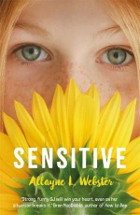Sensitive by Allayne Webster

UQP, 2019. ISBN: 9780702260483.
(Age: 11+) Highly recommended. Themes: Skin diseases, Eczema,
Psoriasis, South Australia, School, Growing up. In moving to a new
town where her father now teaches, Samantha wants to hide her old
self, calling herself SJ and hoping that the others at school do not
notice her flaky, sensitive skin, prone to redness and itchiness.
She has chronic eczema, and is prone to relapses of horrid flaking,
burning skin, often red with scratching, weeping and raw.
Webster details the gratuitous solutions offered by people around
her with wonderful understanding; people's opinions are given
without thought, and certainly not asked for, her desperate parents
at the rough end of the questioning and uncalled for solutions.
SJ is on the cusp of teen age and her emotions are fraught, body
image is all, her periods have started, she is interested in a boy
in her class, also called Sam, and she has to navigate the trials of
being new in a small school where long term relationships have been
established. Along with this pain at school, she must endure an over
protective mother and a new doctor who thinks she knows the solution
to the problem. At their wits' end, they try her solution but this
ends up with SJ in hospital, her raw wounds and poor diet leaving
her open to life threatening infection.
Transferred to Adelaide Women's and Children's Hospital, she meets a
fifteen year old, suffering from psoriasis and the two develop
a bond, a friendship born out of having a similar problem, and their
honesty with each other develops an honesty within Sam that she can
now use when dealing with other people.
Back home in Kingston, South East, she opens up to her new friend,
Livvy, and calling in to see her at home, meets her morbidly obese
mother and together the two share their thoughts, surprising both of
them.
Sam develops throughout the novel, learning to accept her disease
but equally hoping a cure will be found, relying on specialists for
advice, and learning to ignore the often ignorant advice from non
practitioners.
A truth rings through the story as Webster suffers from this disease
and many of the incidents she relates in the book happened to her as
a young girl. It is hoped that a book such as this will draw people's
attention to the fine line that some walk everyday, navigating their
way through the many things which may enhance an allergic reaction,
but of course also reading a good story well told of one young
girl's development. Teacher's
notes are available.
Fran Knight